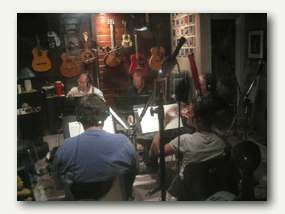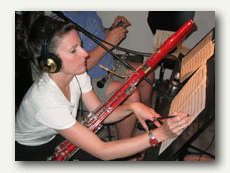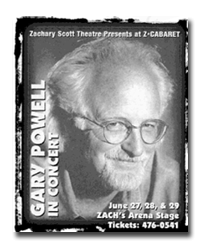by Gary Powell, ProducerÂ
Helen Darling writer of “Bring on the Rain” (performed by Jo Dee Messina) is in the studio today recording a publishing demo for her new song, “Mistake” co-written with Gary Burr. Helen and I have been working together in the studio since 1985! The session was recorded in Digital Performer 4.5 using GigaStudio3 with Larry Seyer’s Acoustic Bass Library. Larry is also playing the guitar, mandolin and slide guitar parts in person. Larry and I have been working together in the studio since 1978! The guitars are being cut with a stereo pair (AT4033) through Mark McQuilken’s RNP
(Really Nice Preamp).
This combination of mic and pre makes for a beautifully crisp guitar sound – no EQ needed. These are my old and good friends to say the least. And yes, Helen, we know you are 1.5 versions younger than Larry and me! Nice day in the studio.
by Gary Powell, ProducerÂ
Helen Darling writer of “Bring on the Rain” (performed by Jo Dee Messina) is in the studio today recording a publishing demo for her new song, “Mistake” co-written with Gary Burr. Helen and I have been working together in the studio since 1985! The session was recorded in Digital Performer 4.5 using GigaStudio3 with Larry Seyer’s Acoustic Bass Library. Larry is also playing the guitar, mandolin and slide guitar parts in person. Larry and I have been working together in the studio since 1978! The guitars are being cut with a stereo pair (AT4033) through Mark McQuilken’s RNP
(Really Nice Preamp).
This combination of mic and pre makes for a beautifully crisp guitar sound – no EQ needed. These are my old and good friends to say the least. And yes, Helen, we know you are 1.5 versions younger than Larry and me! Nice day in the studio.
by Gary Powell

Ensemble: Wild Basin Winds
Recording Dates: 4/10,11,13/2005
Click Here for Session Photos
The woodwind quintet ensemble (flute, clarinet, oboe, horn, bassoon) creates a unique challenge in the recording studio. The flute speaks upward, the clarinet speaks downward, the oboe speaks downward, the horn speaks to the rear and the bassoon speaks from the middle of the instument for its middle range and speaks upward for its lower register. Sonically, in my space the horn’s warm sound permeated the room and the oboe’s lanquid sound bleeds into all the microphones. The accepted method is to record this ensemble with the classical setup of a stereo pair about 10 feet in front of the group. This traditional setup asks a lot from the room to do the mixing for you. Fine if the room sounds good, but this will not produce a sound with the kind of presence that I wanted. A quick call to engineer guru, Larry Seyer, helped me try both setups described below. Wild Basin Winds was recording Christmas arrangements by Gary Slechta. Half of these beautifully written charts were classical in nature and the other half were written in a very creative swing big band style. Amazingly enough, these players were adept in both styles.

Classical Setup: Two stereo pair. The first pair was parallel with the foward most players (oboe/flute) and about 5 feet above. The second pair was at the same height, but about 3 feet behind the rear most player (horn).
Swing Band Setup: Each player was individually mic’d in accordanced with the characteristics of each instrument mentioned above. FLUTE: (AKG414) placed 3 feet above. CLARINET: (AKG414) 1 foot below the bell. HORN: (Audio Technica 4033a) 3 feet behind the bell. BASSOON: (Audix i5) 1 foot directed mid-instrument. OBOE: (Rode NTV) 1 foot below the bell.
Using two different setups worked well because of the dual nature of Gary Slechta’s charts. However, if I had it to do over, I would choose the Swing Band setup with the invidual microphones with its ability to sculpt the mix. I also prefer the close mic’d sound, even for classical ensembles. This preference is not widely shared, however.
We also optioned many microphones and all seemed happy with the final choices listed above. My thanks to Mathew Krejci (Flute), Gary Sperl (Clarinet), Tom Hale (Horn), Daris Word Hale (Bassoon), Ian Davidson (Oboe) and Gary Slechta (Arranger) for three fun, musically inspiring days with outstanding musicians and musicianship.
by Gary Powell

Ensemble: Wild Basin Winds
Recording Dates: 4/10,11,13/2005
Click Here for Session Photos
The woodwind quintet ensemble (flute, clarinet, oboe, horn, bassoon) creates a unique challenge in the recording studio. The flute speaks upward, the clarinet speaks downward, the oboe speaks downward, the horn speaks to the rear and the bassoon speaks from the middle of the instument for its middle range and speaks upward for its lower register. Sonically, in my space the horn’s warm sound permeated the room and the oboe’s lanquid sound bleeds into all the microphones. The accepted method is to record this ensemble with the classical setup of a stereo pair about 10 feet in front of the group. This traditional setup asks a lot from the room to do the mixing for you. Fine if the room sounds good, but this will not produce a sound with the kind of presence that I wanted. A quick call to engineer guru, Larry Seyer, helped me try both setups described below. Wild Basin Winds was recording Christmas arrangements by Gary Slechta. Half of these beautifully written charts were classical in nature and the other half were written in a very creative swing big band style. Amazingly enough, these players were adept in both styles.

Classical Setup: Two stereo pair. The first pair was parallel with the foward most players (oboe/flute) and about 5 feet above. The second pair was at the same height, but about 3 feet behind the rear most player (horn).
Swing Band Setup: Each player was individually mic’d in accordanced with the characteristics of each instrument mentioned above. FLUTE: (AKG414) placed 3 feet above. CLARINET: (AKG414) 1 foot below the bell. HORN: (Audio Technica 4033a) 3 feet behind the bell. BASSOON: (Audix i5) 1 foot directed mid-instrument. OBOE: (Rode NTV) 1 foot below the bell.
Using two different setups worked well because of the dual nature of Gary Slechta’s charts. However, if I had it to do over, I would choose the Swing Band setup with the invidual microphones with its ability to sculpt the mix. I also prefer the close mic’d sound, even for classical ensembles. This preference is not widely shared, however.
We also optioned many microphones and all seemed happy with the final choices listed above. My thanks to Mathew Krejci (Flute), Gary Sperl (Clarinet), Tom Hale (Horn), Daris Word Hale (Bassoon), Ian Davidson (Oboe) and Gary Slechta (Arranger) for three fun, musically inspiring days with outstanding musicians and musicianship.
I’ve been a fan of GigaStudio since it first came out. I’ve also been working with Larry Seyer in the studio since 1978. He’s played guitar and/or mixed over 100 albums I’ve produced. The Larry Seyer Acoustic Bass library has been a staple with me for years and now he’s given us the Acoustic Drum Library. Check out his site and download the video demo which is a quick tutorial of the library all shot in my studio. The sounds are awesome and so is the interface.
I’ve been a fan of GigaStudio since it first came out. I’ve also been working with Larry Seyer in the studio since 1978. He’s played guitar and/or mixed over 100 albums I’ve produced. The Larry Seyer Acoustic Bass library has been a staple with me for years and now he’s given us the Acoustic Drum Library. Check out his site and download the video demo which is a quick tutorial of the library all shot in my studio. The sounds are awesome and so is the interface.

by Gary Powell
This was my first one-man show titled after my book by the same name. The book was written in the early 1980’s as the musings of a young man struggling with learning how to manage a young career burdened with heavy expectations, talent and self-doubt. No doubt this work would have been a blog had they existed in 1982. I never liked having to run the gauntlet of record companies, so I was determined to write a book and publish it without asking any authorities’ permission. “Maybe I’m It, Maybe I’m Not” is that effort. Fifteen years later, I adapted the work into a solo musical performance at Zachary Scott Theatre Center in Austin, Texas and performed it in the Spring of 1997.

by Gary Powell
This was my first one-man show titled after my book by the same name. The book was written in the early 1980’s as the musings of a young man struggling with learning how to manage a young career burdened with heavy expectations, talent and self-doubt. No doubt this work would have been a blog had they existed in 1982. I never liked having to run the gauntlet of record companies, so I was determined to write a book and publish it without asking any authorities’ permission. “Maybe I’m It, Maybe I’m Not” is that effort. Fifteen years later, I adapted the work into a solo musical performance at Zachary Scott Theatre Center in Austin, Texas and performed it in the Spring of 1997.
This is composer, Gary Powell’s 2nd one-man show under development right now. Gary Powell’s productions have sold over 30 million albums in 47 countries. He has taught at the University of Texas at Austin and continues to lecture and coach. Watch how the development of this performance art is conceived and produced. The first show presented in 1997 is now entitled “Maybe I’m It, Maybe I’m Not”.


